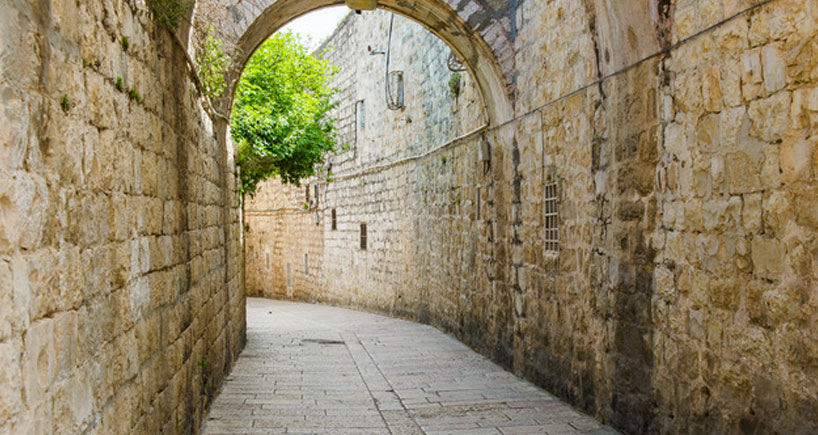One of the most hallowed landmarks in the Old City of Jerusalem is the Via Dolorosa (translated from Latin meaning path of grief or way of sorrows), a narrow path through the streets of the Old City traditionally identified with the final route traveled by Jesus of Nazareth on the way to His crucifixion.
Located in the Christian Quarter of the Old City, the Via Dolorosa winds through a maze of small alleys and bazaars around several of Christianity’s holiest sites. While visitors and pilgrims can opt to walk the Via Dolorosa on their own, or in guided groups, many convene just inside St. Stephen’s Gate (Lions’ Gate) on Friday afternoons to accompany a procession of Franciscan friars on the roughly 500-meter (0.3 mile) route through the 14 Stations of the Cross, which depict Jesus’ path of suffering from the moment of His judgment by Pontius Pilate, and culminating in His crucifixion.
Before beginning the Via Dolorosa
Between the Lion’s Gate and the first station of the cross is the church of St Anne. It is arguably one of the best examples of Crusader architecture. Inside the church, guests are encouraged to sing and experience the impressive acoustics. Adjacent to the Church of St Anne are remains of the Pools of Bethesda from biblical times. It was here that Jesus healed the man who had not walked in 38 years (John 5).
Station 1 – Jesus Condemned To Death
While there are three possible locations for the praetorium mentioned in John 18:28, early pilgrims to the Holyland believed it was located in the Antonia Fortress. This Roman military garrison, constructed by Herod the Great, was located on the northwest corner of the Temple Mount. This is where Jesus was sentenced to death and condemned to crucifixion (John 19:16). This is the first station of the cross and where the Via Dolorosa begins.
Station 2 – Jesus Receives His Cross
This is located near the compound of the Franciscan monastery, across the street from the first station. This is where Jesus is given His cross (John 19:17). There are two churches in the Franciscan compound – the Flagellation and the Condemnation.
Adjacent to the Franciscan compound is the Sisters of Zion Convent where pavement markings suggest this may be the site where Jesus was mocked by Roman soldiers as they played the “Games of Kings” (John 19:2-3).
Ecce Homo Arch – Between Station 2 And Station 3
Built by Hadrian over 100 years after Jesus’s death, the Ecce Homo arch commemorates the moment Pontius Pilate presented the scourged Jesus of Nazareth to the crowd (John 19:5), the Latin phrase “Ecce homo” translates to “Behold the man”.
Station 3 – Jesus Falls Under His Cross For The First Time (Traditional)
Station 4 – Jesus Meets His Mother, Mary (Traditional – commemorating John 19:26)
Station 5 – Simon Of Cyrene Helps Jesus Carry His Cross (Luke 23:26)
Station 6 – Veronica Wipes The Face Of Jesus (Traditional – based on Luke 23:27)
Station 7 – Jesus Falls The Second Time (Traditional)
Station 8 – Jesus Speaks To The Women (Traditional – based on Luke 23:27)
Station 9 – Jesus Falls The Third Time (Traditional)
Church of the Holy Sepulchre
Location of the last five Stations of the Cross, the Church of the Holy Sepulchre is the final stopping place of the journey.
Station 10 – Jesus Stripped Of His Garments (Mark15:24)
This station is located at the entrance of the Church of the Holy Sepulchre, in the room called the Chapel of the Franks.
The remaining stations are all located inside the Church of the Holy Sepulchre—
Station 11 – Jesus Nailed To The Cross
Station 12 – Jesus Dies On The Cross
Station 13 – Jesus Is Taken Down From The Cross (Based on John 19:40)
Station 14 – Jesus Is Laid In The Tomb
While there is disagreement among scholars about the historical validity of the Via Dolorosa being the actual path of Jesus’ final footsteps on Good Friday, the practice of following the Stations of the Cross is an unforgettable experience for many who undertake it.















